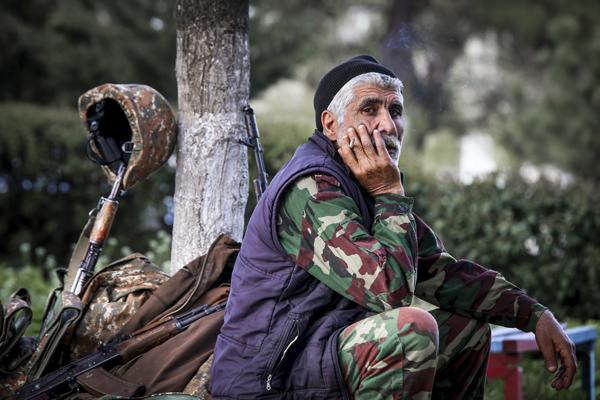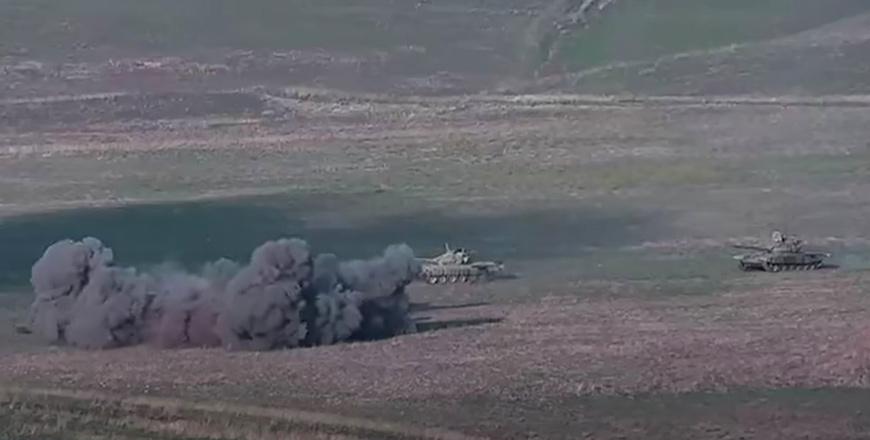You are here
Nagorny Karabakh clashes continue despite Azerbaijan ‘ceasefire’
By AFP - Apr 03,2016 - Last updated at Apr 03,2016

In this photo taken on Saturday, an Armenian volunteer is in a state of readiness in the town of Askeran in the separatist Nagorno-Karabakh region (AP photo)
TERTER, Azerbaijan — Clashes between Azerbaijani and Armenian forces rumbled on Sunday, despite Baku announcing a ceasefire after the worst outbreak of violence in decades over the disputed Nagorny Karabakh region sparked international pressure to stop fighting.
Azerbaijan said it had decided to "unilaterally cease hostilities" and pledged to "reinforce" several strategic positions it claimed to have captured inside the Armenian-controlled territory.
The Armenia-backed authorities in Karabakh — which claims independence but is heavily backed by Yerevan — said they were willing to discuss a ceasefire but only if it saw them regain their territory.
Both sides accused each other of continuing to fire across the volatile frontline that has divided them since a war that saw Armenian separatists seize the region from Azerbaijan ended with an inconclusive truce in 1994.
"The Armenians have continued shelling throughout the day, without interruption," Azerbaijani defence ministry spokesman Vagif Dargahly told AFP.
"Fighting with the use of tanks and artillery continues as Azerbaijan is telling lies that it halted hostilities. Azerbaijan continues shelling both Karabakh army positions and Armenian villages," Armenian defence ministry spokesman Artsrun Hovhannisyan told AFP.
An AFP photographer in the Azerbaijani town of Terter — around 10 kilometres from the frontline — reported hearing sporadic shooting Sunday afternoon.
Men carried a coffin draped in Azerbaijan's flag through the streets as the funeral of an Azeri soldier killed in the clashes was held. At least three houses were destroyed by shelling, and women and children had been evacuated.
Fierce clashes left at least 18 Armenian and 12 Azerbaijani soldiers dead Saturday after the two sides accused each other of attacking with heavy weaponry across the volatile frontline.
The Karabakh authorities said one boy was killed in the fighting, while Azerbaijan said two civilians died and ten were wounded.
Armenia's President Serzh Sarkisian called the clashes the "largest-scale hostilities" since a 1994 truce ended a war in which Armenian-backed fighters seized the territory from Azerbaijan.
Azerbaijan said one of its helicopters was shot down as its forces took control of several strategic heights and a village in Armenian-controlled territory.
Karabakh forces on Sunday claimed they took back the strategic Lala-Tepe height in Karabakh which was captured by Azeri troops on Saturday.
Baku denied the report, saying that the height remained under its control and that rebel troops sustained "serious manpower losses".
Both Russia and the West appealed to all sides to show restraint, with key regional power broker President Vladimir Putin calling Saturday for an "immediate ceasefire".
Moscow has supplied weaponry to both sides in the conflict, but has much closer military and economic ties to Armenia and Yerevan is reliant on Russia's backing.
US Secretary of State John Kerry urged the arch foes to return to peace talks under the auspices of the Organisation for Security and Cooperation in Europe (OSCE), reiterating "there is no military solution to the conflict".
Turkish President Recep Tayyip Erdogan meanwhile vowed to back traditional ally Azerbaijan "to the end" in the conflict.
"We pray our Azerbaijani brothers will prevail in these clashes with the least casualties," Erdogan said.
Ethnic Armenian separatists backed by Yerevan seized control of the mountainous Nagorny Karabakh region in an early 1990s war that claimed some 30,000 lives. The foes have never signed a peace deal despite the 1994 ceasefire.
Energy-rich Azerbaijan, whose military spending has in the past exceeded Armenia's entire state budget, has repeatedly threatened to take back the breakaway region by force if negotiations fail to yield results.
Moscow-backed Armenia says it could crush any offensive.
The last big flare-up occurred in November 2014 when Azerbaijan shot down an Armenian military helicopter.
While the reasons for the sudden surge remain unclear, analyst Thomas de Waal of Carnegie Europe wrote that the "potential for a serious outbreak of fighting has never been greater" as both sides have bolstered their arms.
"It is more likely that one of the two parties to the conflict — and more likely the Azerbaijani side, which has a stronger interest in the resumption of hostilities — is trying to alter the situation in its favor with a limited military campaign," de Waal wrote in a blog posting.
Related Articles
YEREVAN/BAKU — Fierce clashes left at least 30 Azerbaijani and Armenian soldiers dead Saturday as Russia and the West urged an immediate cea
YEREVAN — Armenia and Azerbaijan rejected international calls for negotiations and a halt to fighting as fierce clashes over the disputed re
YEREVAN — Baku and Yerevan put themselves on a war footing after heavy fighting erupted on Sunday between Azerbaijan and Armenian sepa



















